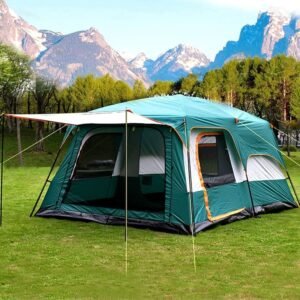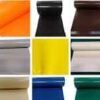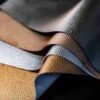When it comes to camping, the fabric of your tent plays a crucial role in determining its overall performance, durability, and comfort. Whether you’re embarking on a weekend getaway or an extended outdoor adventure, understanding how different tent fabrics impact your experience can make all the difference. In this blog, we’ll explore how the fabric used in tents affects both their durability and the comfort of your camping experience, from weather resistance to breathability.
The Importance of Tent Fabric
The material used in tents is more than just a barrier against the elements. It directly impacts the performance, weight, ease of setup, and long-term usability of the tent. Depending on the type of fabric, your shelter will be better suited for various weather conditions, provide more comfort during long stays, and offer protection against the sun, rain, and wind. Here’s how fabric affects these key factors.
Durability of Tent Fabrics
One of the most critical factors when choosing a tent is its ability to withstand harsh outdoor conditions. Tent materials are generally made from either natural fibers, like cotton, or synthetic options, like polyester and nylon. Each material has distinct advantages when it comes to durability.
- Polyester and Nylon
Synthetic fabrics like polyester and nylon are commonly used in modern tents. They are highly durable, resistant to tearing, and can withstand exposure to the elements better than natural fibers. These fabrics are also lightweight, which is especially important for backpackers who need to keep their gear minimal. Additionally, these synthetic materials are often treated with coatings that enhance their durability. For example, polyester tents are often coated with UV-resistant treatments that prevent fabric degradation under sunlight, making them ideal for sunny camping trips. - Cotton Canvas
Cotton canvas is another option, typically used in more traditional camping setups. While it is heavier and less compact than synthetic fabrics, it offers superior durability and resilience. Cotton canvas tents are known for their ability to withstand high winds and heavy rain, providing a more robust shelter in challenging conditions. They are also naturally breathable, which helps regulate the internal temperature of the tent. However, cotton canvas tents require more maintenance to keep them in good condition, as they can be prone to mold and mildew if not cared for properly.

Weather Resistance
Tent fabric plays a significant role in protecting you from the elements. Whether you’re facing rain, snow, or scorching heat, the material determines how well your tent stands up to weather conditions. Let’s break down how different fabrics handle various environmental challenges.
- Water Resistance
Water resistance is a crucial feature for tents, particularly in rainy conditions. Polyester and nylon are often treated with waterproof coatings, such as polyurethane (PU) or silicone, to prevent water from seeping through. These coatings help keep the inside of the tent dry, even during heavy rainfall. The denier (thickness of the fibers) of the fabric also affects water resistance—higher denier fabrics generally provide better waterproofing. - UV Resistance
Prolonged exposure to sunlight can degrade tent fabrics over time, causing them to lose strength and color. UV-resistant coatings are applied to most synthetic tent fabrics, especially polyester, to protect against UV rays. This not only increases the longevity of the material but also helps maintain the tent’s color vibrancy. Cotton canvas tents, while naturally UV-resistant, tend to fade more over time compared to synthetic options. - Wind Resistance
Strong winds can put a lot of stress on a tent, and the fabric plays a significant role in its ability to withstand gusts. Stronger materials, like high-denier polyester or cotton canvas, offer better wind resistance. Additionally, a well-designed tent with reinforced stitching and added support features (like guylines) can help ensure stability even in high winds.
Comfort Inside Your Tent
While durability is essential, comfort is just as important when spending time in your tent. The right fabric can make a huge difference in the internal atmosphere of your shelter, especially if you plan to stay for an extended period.
- Breathability
One of the most significant factors affecting comfort is breathability. Fabrics like cotton canvas are naturally breathable, allowing moisture and heat to escape, which helps prevent condensation buildup inside the tent. This feature is especially important in warmer climates or during humid nights, as trapped moisture can make the interior feel damp and uncomfortable.In contrast, synthetic materials like polyester and nylon tend to trap more moisture inside the tent, leading to condensation. However, many modern tents made from these fabrics include mesh panels and ventilation windows to help improve airflow and reduce condensation. - Temperature Regulation
Temperature regulation is another essential factor for comfort. In colder weather, synthetic fabrics are good at retaining heat, which helps keep the interior warm. However, in hotter conditions, these fabrics may make the inside of the tent feel stuffy. Cotton canvas tents, on the other hand, naturally provide better ventilation, which helps to keep the interior cooler, making them a great choice for hot-weather camping. - Noise Reduction
Some tent fabrics, especially thicker materials like cotton, provide better sound insulation, reducing the noise from wind and rain. This can be important if you’re camping in a windy or rainy location and want a quieter, more peaceful environment. Synthetic tents, while durable, may not offer the same level of sound insulation, which can result in more noise from the surrounding environment.
Choosing the Right Fabric for Your Tent
When selecting a tent, consider the conditions you’ll be camping in. For lightweight, easy-to-set-up tents suitable for fair-weather conditions, polyester or nylon fabrics are excellent options due to their strength, water resistance, and UV protection. If you’re planning on camping in extreme conditions, like heavy rain or snow, a cotton canvas tent may provide superior durability and weather resistance, though it comes with added weight and maintenance needs.
Additionally, think about the duration of your trips and the number of people using the tent. For short, casual camping excursions, lightweight synthetic fabrics may suffice. For longer or more rugged adventures, a heavier-duty cotton canvas tent may offer better long-term durability and comfort.
Conclusion
The fabric used in your tent is integral to both its durability and your comfort during your camping experience. Whether you choose a lightweight polyester tent for a weekend getaway or a heavy-duty cotton canvas tent for extended adventures, the fabric will determine how well your shelter performs in different conditions and how comfortable you feel inside. By understanding the properties of various materials, you can choose the perfect tent fabric for your next outdoor adventure, ensuring your time in nature is both enjoyable and safe.











Leave a reply